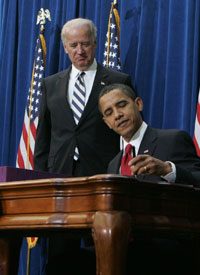
The president says that the new law will create more than 3.5 million jobs over two years. Some of those jobs will be “green” energy-related jobs, and to underscore this point, Obama signed the bill at the Denver Museum of Nature and Science, which has solar panels on its roof. Of course, Obama did not note that the new jobs the stimulus bill is supposed to create come with a hefty price tag — about $225,000 per job, a figure that easily can be calculated by dividing the new law’s total cost by the number of jobs the law will purportedly create.
The government does not create wealth, after all, and the $787 billion will ultimately have to be drained from the economy, thereby destroying countless jobs throughout the American economy in order to create 3.5 million “green” and other jobs in government-favored sectors.
But is it fair to view the entire $787 billion as a drain on the U.S. economy, considering that $212 billion of this amount is for tax cuts? The tax cuts are problematic in that there are no corresponding spending cuts, which means that the government will have to borrow even more money than before in order to spend as much as before. As money as created out of thin air by the Federal Reserve in order to finance the ballooning federal indebtedness, the result is an expansion of the money supply (inflation) followed by higher prices.
But of course, the government will be spending much more than before under the new stimulus law, $575 billion more than before.
Yet, this massive increase in government spending — for jobless benefits, education, low-income assistance, highway construction projects, Medicaid, public housing, etc. — is only part of what President Obama says needs to be done to reinvigorate the economy. As the president said when he signed the stimulus bill in Denver: "I don’t want to pretend that today marks the end of our economic problems. Nor does it constitute all of what we have to do to turn our economy around. But today does mark the beginning of the end.”
What else needs to be done?
A joint statement issued on February 10 by Treasury Secretary Timothy Geithner, Federal Reserve Chairman Ben Bernanke, and other officials provides part of the answer. According to the statement, core programs that the Fed and the federal government will pursue to help the economy and credit flowing include:
• A new Capital Assistance Program to help ensure that our banking institutions have sufficient capital to withstand the challenges ahead….
• A new Public-Private Investment Fund on an initial scale of up to $500 billion, with the potential to expand up to $1 trillion, to catalyze the removal of legacy assets from the balance sheets of financial institutions. This fund will combine public and private capital with government financing to help free up capital to support new lending.
• A new Treasury and Federal Reserve initiative to dramatically expand — up to $1 trillion — the existing Term Asset-Backed Securities Lending Facility (TALF) in order to reduce credit spreads and restart the securitized credit markets that in recent years supported a substantial portion of lending to households, students, small businesses, and others.
The joint statement added: “Alongside this program, the Administration will launch a comprehensive program to help address the housing crisis.” Tomorrow, in Phoenix, the president will reportedly announce how his administration intends to spend at least $50 billion to combat the mortgage-foreclosure problem. And this spending will be just part of the $700 billion in TARP spending intended to “rescue” financial institutions.
There’s also the bailout of the auto industry: $17 billion already in place for GM and Chrysler, and likely more to come.
In short, the Obama administration and the Fed are trying to “stimulate” the economy through literally trillions of dollars of additional spending and debt. Their plan will stimulate government, but it will not stimulate the economy.
Photo: AP Images



